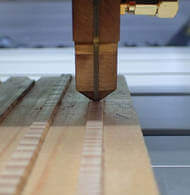New research from the University of Munich (TUM) shows that although climate change has made trees grow faster, it has made wood less dense or lighter.
One would think that faster tree growth would be beneficial, because trees store excess carbon dioxide from the atmosphere in their wood.
But it’s not that simple.
Trees with lighter wood cannot absorb the same amount of carbon as their ancestors.
Europe still calculates the quantity of carbon a forest can sequester by using outdated wood density estimations, thus producing inaccurate calculations.
“The accelerated growth is still resulting in surplus carbon sequestration,” Hans Pretzsch, a professor of forest growth and yield science at TUM, said in a statement.
“But scaling up for the forests of central Europe, the traditional estimate would be to high by about 10 million metric tons of carbon per year.”
Additionally, lighter wood could negatively impact construction and energy production. Less-dense trees are also more susceptible to breakage during wind, rain or snow storms.
The study
The researchers were motivated to conduct this study because they wanted to monitor the human footprint on forests, and they wanted to be able to give expert advice to forest and wood practitioners, said Pretzsch.
The team analyzed samples from several hundred trees and examined 30,000 age-indicating tree rings by using a Lignostation, a high-tech density calculator.

Image: P. Biber/TUM
“The heart of the Lignostation is a high-frequency probe which scans each sample in steps of a hundredth of a millimeter,” Pretzsch said in a statement. “By doing so, we measure the specific weight of the wood with an accuracy and resolution which until recently was unthinkable.”

Image: P. Biber/TUM
The researchers gathered their wood samples from the oldest experimental forest plots in Europe, established 150 years ago.
They evaluated the wood of spruces, pines, beeches and oaks — all of central Europe’s most common tree species.
“We have detailed knowledge of the history of every single plot and tree”, Pretzsch said in a statement. “This allows us to rule out the possibility that our findings could result from the forest being managed differently now as compared to a hundred years ago.”
The researchers compared all of the wood samples of trees ranging from 150-years-old to new life.
They concluded that the wood has gradually become lighter over time. Wood density has decreased by eight to 12 percent since 1900, while the number of trees growing in central Europe has increased significantly.
Although more wood is produced today, it contains less material than it used to.
A paper describing the study is published in the journal Forest Ecology and Management.
Blame climate change
The researchers blame climate change for making the wood lighter.
Climate change has caused there to be a higher nitrogen supply, an increase in the growth speed of trees, fertilization via atmospheric deposition and longer vegetation periods. All of these factors play a role into why trees have become less dense, said Pretzsch.
The primary efforts that can be taken to reverse this trend are climate change control and emission control, said Pretzsch.
What’s next?
Pretzsch has spent a long time investigating the effect climate change has on the stability, vitality and growth of trees.
In future studies, the team plans to analyze more tree species and to examine trees under different kinds of stress, said Pretzsch.



